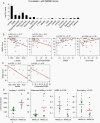Tumor metabolism and neurocognition in CNS lymphoma
- PMID: 33625503
- PMCID: PMC8485453
- DOI: 10.1093/neuonc/noab045
Tumor metabolism and neurocognition in CNS lymphoma
Abstract
Background: The mechanistic basis for neurocognitive deficits in central nervous system (CNS) lymphoma and other brain tumors is incompletely understood. We tested the hypothesis that tumor metabolism impairs neurotransmitter pathways and neurocognitive function.
Methods: We performed serial cerebrospinal fluid (CSF) metabolomic analyses using liquid chromatography-electrospray tandem mass spectrometry to evaluate changes in the tumor microenvironment in 14 patients with recurrent CNS lymphoma, focusing on 18 metabolites involved in neurotransmission and bioenergetics. These were paired with serial mini-mental state examination (MMSE) and MRI studies for tumor volumetric analyses. Patients were analyzed in the setting of the phase I trial of lenalidomide/rituximab. Associations were assessed by Pearson and Spearman correlation coefficient. Generalized estimating equation (GEE) models were also established, adjusting for within-subject repeated measures.
Results: Of 18 metabolites, elevated CSF lactate correlated most strongly with lower MMSE score (P < 8E-8, ρ = -0.67). High lactate was associated with lower gamma-aminobutyric acid (GABA), higher glutamate/GABA ratio, and dopamine. Conversely, high succinate correlated with higher MMSE scores. Serial analysis demonstrated a reproducible, time-dependent, reciprocal correlation between changes in lactate and GABA concentrations. While high lactate and low GABA correlated with tumor contrast-enhancing volume, they correlated more significantly with lower MMSE scores than tumor volumes.
Conclusions: We provide evidence that lactate production and Warburg metabolism may impact neurotransmitter dysregulation and neurocognition in CNS lymphomas. We identify novel metabolomic biomarkers that may be applied in future studies of neurocognition in CNS lymphomas. Elucidation of mechanistic interactions between lymphoma metabolism, neurotransmitter imbalance, and neurocognition may promote interventions that preserve cognitive function.
Keywords: lymphoma metabolism; neurocognition; neurotransmitter pathways.
© The Author(s) 2021. Published by Oxford University Press on behalf of the Society for Neuro-Oncology. All rights reserved. For permissions, please e-mail: journals.permissions@oup.com.
Figures




Comment in
-
Tracking the neurobiology of cognitive dysfunction in primary CNS lymphoma?Neuro Oncol. 2021 Oct 1;23(10):1623-1624. doi: 10.1093/neuonc/noab166. Neuro Oncol. 2021. PMID: 34244795 Free PMC article. No abstract available.
References
-
- Houillier C, Taillandier L, Dureau S, et al. ; Intergroupe GOELAMS–ANOCEF and the LOC Network for CNS Lymphoma . Radiotherapy or autologous stem-cell transplantation for primary CNS lymphoma in patients 60 years of age and younger: results of the intergroup ANOCEF-GOELAMS randomized phase II PRECIS study. J Clin Oncol. 2019;37(10):823–833. - PubMed
-
- van der Meulen M, Dirven L, Habets EJJ, van den Bent MJ, Taphoorn MJB, Bromberg JEC. Cognitive functioning and health-related quality of life in patients with newly diagnosed primary CNS lymphoma: a systematic review. Lancet Oncol. 2018;19(8):e407–e418. - PubMed
Publication types
MeSH terms
Substances
Grants and funding
LinkOut - more resources
Full Text Sources
Other Literature Sources
Medical

